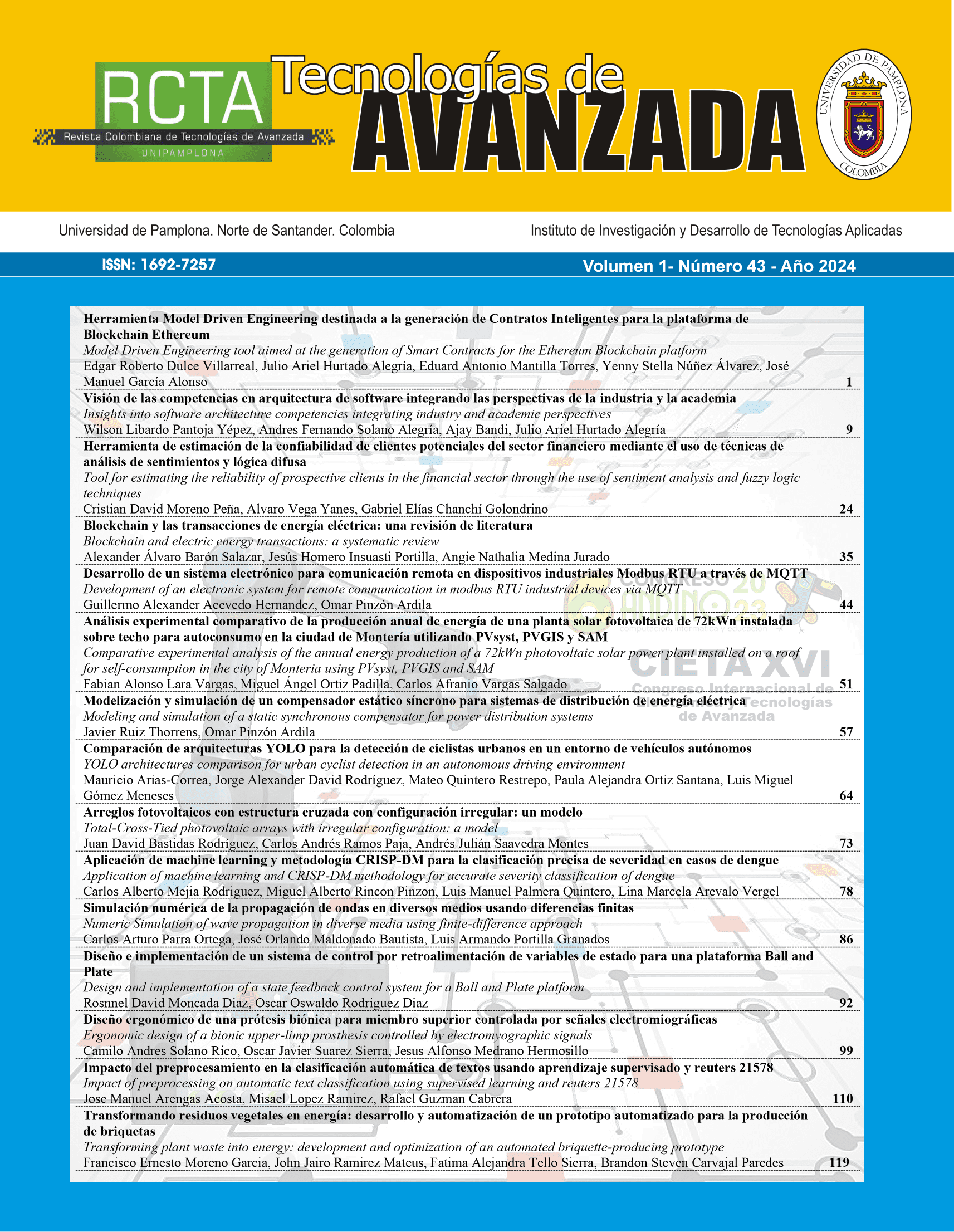Detección de ataques de presentación facial basado en siamese-LSTM y el análisis del flujo óptico y puntos de referencia facial
DOI:
https://doi.org/10.24054/rcta.v1i43.2888Palabras clave:
Biometría, contra la suplantación de identidad, red neuronal siamese, red LSTM, flujo óptico, puntos de referencia facialesResumen
La autenticación por medio de la biometría facial se ha vuelto fundamental para verificar la identidad de las personas en transacciones en línea, ya que mecanismos clásicos como la autenticación por nombre de usuario y contraseña han demostrado ser poco fiables, ya que los usuarios suelen escoger contraseñas que son fáciles de recordar. Sin embargo, el avance en la fabricación de modelos con materiales como el látex, el aumento en la calidad de las impresiones y la mejora en las resoluciones de las pantallas han exigido que los sistemas de detección de fraude se adapten rápidamente a las nuevas condiciones. El presente trabajo muestra una propuesta para abordar el problema de la detección de ataques de presentación por medio de la extracción del flujo óptico y los puntos de referencia facial y su análisis por medio de una red siamese. Para evaluar el modelo propuesto, se utilizaron tres data sets: Rose-youtu, Replay-attack y Replay-mobile, y las métricas HTER y EER.
Descargas
Referencias
S. Jia, G. Guo, Z. Xu, and Q. Wang, “Face presentation attack detection in mobile scenarios: A comprehensive evaluation,” Image and Vision Computing, vol. 93, p. 103826, Jan. 2020, doi: 10.1016/j.imavis.2019.11.004.
S. Kumar, S. Singh, and J. Kumar, A Comparative Study on Face Spoofing Attacks. 2017.
Y. Xin et al., “A survey of liveness detection methods for face biometric systems,” Sensor Review, vol. 37, no. 3, pp. 346–356, Jul. 2017, doi: 10.1108/SR-08-2015-0136.
J. H. Tu, C. W. Rowley, D. M. Luchtenburg, S. L. Brunton, and J. N. Kutz, “On Dynamic Mode Decomposition: Theory and Applications,” Journal of Computational Dynamics, vol. 1, no. 2, pp. 391–421, Dec. 2014, doi: 10.3934/jcd.2014.1.391.
L. Li, X. Feng, Z. Xia, X. Jiang, and A. Hadid, “Face spoofing detection with local binary pattern network,” Journal of Visual Communication and Image Representation, vol. 54, pp. 182–192, Jul. 2018, doi: 10.1016/j.jvcir.2018.05.009.
Z. Wang et al., “Deep Spatial Gradient and Temporal Depth Learning for Face Anti-spoofing.” arXiv, Mar. 18, 2020. doi: 10.48550/arXiv.2003.08061.
X. Tu et al., “Learning Generalizable and Identity-Discriminative Representations for Face Anti-Spoofing,” arXiv:1901.05602 [cs], Jan. 2019, Accessed: Nov. 10, 2019. [Online]. Available: http://arxiv.org/abs/1901.05602
V. Ruiz, I. Linares, A. Sanchez, and J. F. Velez, “Off-line handwritten signature verification using compositional synthetic generation of signatures and Siamese Neural Networks,” Neurocomputing, vol. 374, pp. 30–41, Jan. 2020, doi: 10.1016/j.neucom.2019.09.041.
A. Niknam, H. K. Zare, H. Hosseininasab, and A. Mostafaeipour, “Developing an LSTM model to forecast the monthly water consumption according to the effects of the climatic factors in Yazd, Iran,” Journal of Engineering Research, vol. 11, no. 1, p. 100028, Mar. 2023, doi: 10.1016/j.jer.2023.100028.
A. Al Hamoud, A. Hoenig, and K. Roy, “Sentence subjectivity analysis of a political and ideological debate dataset using LSTM and BiLSTM with attention and GRU models,” Journal of King Saud University - Computer and Information Sciences, vol. 34, no. 10, Part A, pp. 7974–7987, Nov. 2022, doi: 10.1016/j.jksuci.2022.07.014.
L. Li, Z. Xia, J. Wu, L. Yang, and H. Han, “Face presentation attack detection based on optical flow and texture analysis,” Journal of King Saud University - Computer and Information Sciences, vol. 34, no. 4, pp. 1455–1467, Apr. 2022, doi: 10.1016/j.jksuci.2022.02.019.
C. Wang, B. Yu, and J. Zhou, “A Learnable Gradient operator for face presentation attack detection,” Pattern Recognition, vol. 135, p. 109146, Mar. 2023, doi: 10.1016/j.patcog.2022.109146.
S. Fatemifar, S. R. Arashloo, M. Awais, and J. Kittler, “Client-specific anomaly detection for face presentation attack detection,” Pattern Recognition, vol. 112, p. 107696, Apr. 2021, doi: 10.1016/j.patcog.2020.107696.
M. Pei, B. Yan, H. Hao, and M. Zhao, “Person-Specific Face Spoofing Detection Based on a Siamese Network,” Pattern Recognition, vol. 135, p. 109148, Mar. 2023, doi: 10.1016/j.patcog.2022.109148.
C. Yuan, Q. Cui, X. Sun, Q. M. J. Wu, and S. Wu, “Chapter Five - Fingerprint liveness detection using an improved CNN with the spatial pyramid pooling structure,” in Advances in Computers, A. R. Hurson and S. Wu, Eds., Elsevier, 2021, pp. 157–193. doi: 10.1016/bs.adcom.2020.10.002.
X. Cheng, J. Zhou, X. Zhao, H. Wang, and Y. Li, “A presentation attack detection network based on dynamic convolution and multi-level feature fusion with security and reliability,” Future Generation Computer Systems, Apr. 2023, doi: 10.1016/j.future.2023.04.012.
X. Shu, X. Li, X. Zuo, D. Xu, and J. Shi, “Face spoofing detection based on multi-scale color inversion dual-stream convolutional neural network,” Expert Systems with Applications, vol. 224, p. 119988, Aug. 2023, doi: 10.1016/j.eswa.2023.119988.
S. Fatemifar, S. Asadi, M. Awais, A. Akbari, and J. Kittler, “Face spoofing detection ensemble via multistage optimisation and pruning,” Pattern Recognition Letters, vol. 158, pp. 1–8, Jun. 2022, doi: 10.1016/j.patrec.2022.04.006.
S. R. Arashloo, “Unknown Face Presentation Attack Detection via Localised Learning of Multiple Kernels.” 2022.
“How do Siamese Networks Work in Image Recognition? | Baeldung on Computer Science.” https://www.baeldung.com/cs/siamese-networks (accessed Apr. 09, 2023).
G. He, F. Li, Q. Wang, Z. Bai, and Y. Xu, “A hierarchical sampling based triplet network for fine-grained image classification,” Pattern Recognition, vol. 115, p. 107889, Jul. 2021, doi: 10.1016/j.patcog.2021.107889.
Descargas
Archivos adicionales
Publicado
Número
Sección
Licencia
Derechos de autor 2024 Arnold Jair Jimenez Vargas, Rubiel Vargas Cañas, Carlos Alberto Cobos Lozada, Humberto Loaiza Correa

Esta obra está bajo una licencia internacional Creative Commons Atribución-NoComercial 4.0.











